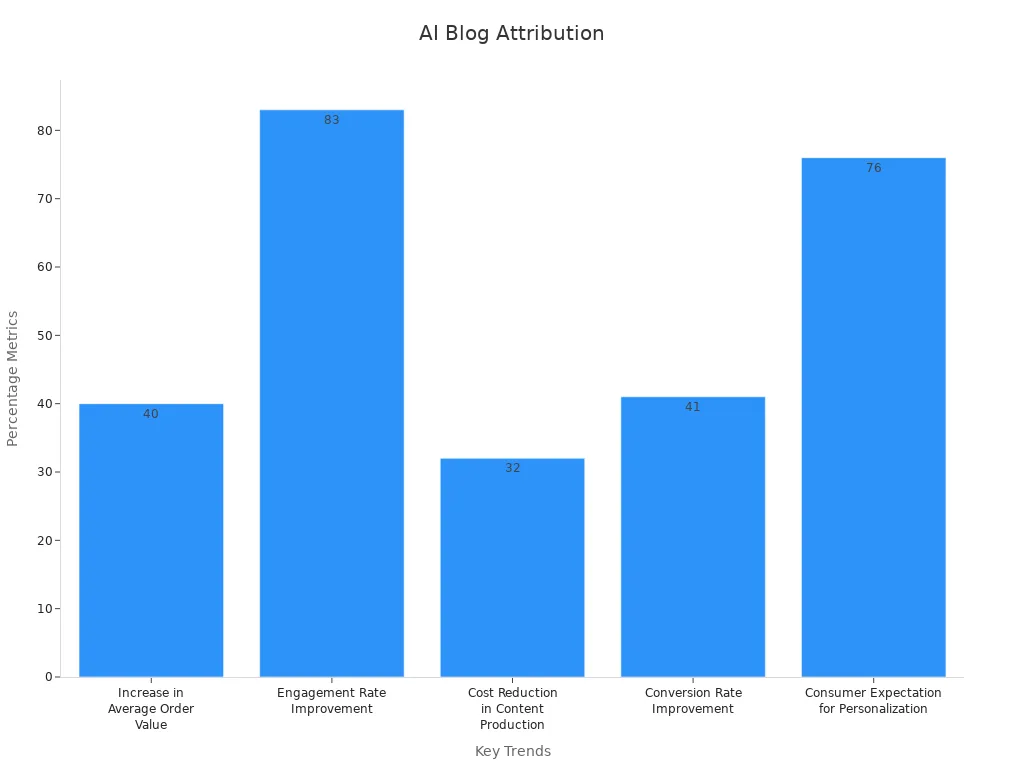Leveraging AI for Blog Content Attribution

Leveraging AI changes how you manage blog content attribution. Imagine you publish a blog post and worry about tracking who created each part or how much impact each section brings to your SEO. AI tools help you solve this by giving accurate data and making your process transparent. You gain clear authorship, ethical content practices, and better results.

Key Takeaways
AI helps track who created each part of your blog and measures its impact automatically and accurately.
Using AI for attribution builds trust with readers and search engines by showing clear authorship and expert content.
Choose AI tools that fit your needs, integrate well with your systems, and offer real-time data and strong security.
Customize and update your AI models regularly to improve accuracy and get better results for your blog.
Always include human oversight and follow privacy rules to keep your AI use ethical, transparent, and trustworthy.
Leveraging AI Basics
What Is AI Attribution
When you create content, you want to know who wrote each part and how it helps your blog. AI attribution means using artificial intelligence to track and assign credit for every section of your blog. This process helps you see which writer or tool made each paragraph, image, or idea. Leveraging AI makes this tracking automatic and accurate. You do not have to guess or check everything by hand. AI can also spot patterns, like which topics get the most attention or which authors drive the most traffic. With these insights, you can improve your content and make better decisions for your blog.
Why It Matters
You might wonder why AI attribution is important for your blog’s success. Leveraging AI helps you build trust and authority with your readers and search engines. When you show clear authorship and use fresh data, your blog stands out. Google and other search engines look for content that shows expertise, experience, authority, and trust (E-E-A-T). AI systems now favor blogs that:
Show original ideas and expert knowledge.
Use case studies and unique research to prove their points.
Include data and clear sources for every claim.
Highlight author credentials and real experience.
Structure answers in a way that is easy for AI and people to understand.
Use internal links to connect related topics and build authority.
Gain backlinks and mentions from trusted sites and brands.
If you publish early and keep your content updated, AI models will notice your blog first. This gives you a better chance to be cited as a top source. When AI platforms pick your blog as a reference, you get more visibility and traffic. Leveraging AI for attribution helps you stay ahead in the fast-changing world of SEO.
Implementation Steps
Tool Selection
You need the right tools to make blog content attribution work with AI. Many companies have seen big results by choosing the right AI-powered platforms. For example, JPMorganChase used Persado to create AI-generated copy, which led to a 450% increase in ad click-through rates. Volkswagen used AI to automate ad-buying and predict customer behavior, boosting sales at dealerships by 20%. Netflix uses AI to study what viewers like and give them better recommendations, which keeps users engaged. These examples show that picking the right tool can change your results.
When you look for a tool, check if it fits your needs. Some popular options for content attribution include:
Postly: Helps you track who created each part of your blog and how it performs.
Copy.ai: Generates content and gives you data on which sections work best.
Jasper: Offers AI writing and analytics to help you see which content drives traffic.
Veritone: Provides enterprise-level media attribution and improves marketing results.
You should also look for tools that offer features like real-time analytics, easy integration, and strong data security. Leveraging AI tools with proven results helps you get accurate attribution and better performance.
Tip: Choose a tool that matches your workflow and supports your long-term goals. Test different platforms to see which one gives you the best insights.
System Integration
After you pick your tool, you need to connect it with your current content system. This step is important for a smooth workflow. Many older content management systems (CMS) do not work well with AI at first. You may need to check your system’s setup and make sure your data is ready. AI can help you keep your brand message the same across all channels by automating how you share content and follow brand rules.
Here are some industry benchmarks for integrating AI with content systems:
Many legacy CMS platforms need an audit before you add AI.
AI can help keep your brand consistent everywhere.
Marketing and development teams must work together for success.
Privacy and security rules like GDPR and CCPA matter when you use AI.
New CMS systems are moving toward flexible, headless designs that work better with AI.
Easy-to-use interfaces help everyone on your team use the system, not just tech experts.
You need to watch system performance to avoid slow load times and SEO problems.
Pick a CMS that can grow with your needs and works well with AI tools.
AI should help your team focus on creative work by handling boring tasks.
A table below shows how companies have gained efficiency by integrating AI with their legacy systems:
Company | Integration Approach | Efficiency Gains / Outcomes |
|---|---|---|
NewGlobe | API-based GenAI with legacy templates | Cut guide creation time from 4 hours to 10 minutes; $835,000 saved |
Newzip | AI hyper-personalization via API | 60% more engagement; 10% more conversions |
Shine | AI transcription in legacy workflows | Saved 2 hours daily per provider; $10.4M saved; 92/100 satisfaction |
Keller Williams | AI CRM via middleware | 170,000 active users; scalable operations |
Various Orgs | Modular AI integration with APIs/middleware | 42% faster time-to-value; 30% higher efficiency; 33% higher ROI |
Leveraging AI in your system can save time, cut costs, and improve results. You should plan your integration with care and make sure your team is ready for the change.
Model Customization
Once you have your tools and systems in place, you can customize your AI models for better attribution. Customization means you adjust the AI to fit your blog’s needs. For example, Target built a special AI model that used both online and offline data. This helped them see which ads worked best and improved their marketing ROI by 20%. ASOS used an AI model to track many types of customer actions, which led to a 28% increase in new customers and 15% better marketing efficiency.
Retailers who use advanced attribution models often see:
15-25% better return on ad spend
30% lower costs to get new customers
20% growth in new customers
12% higher customer retention
To succeed, you need support from leaders, teamwork across departments, and good data quality. You should also set clear goals and measure your results. Metrics like accuracy, precision, recall, and F1-score show how well your AI works. Business results like customer satisfaction, cost savings, and ROI tell you if your model helps your blog grow.
Note: Always review and update your AI models. The market changes fast, and your model needs to keep up to give you the best results.
Leveraging AI for blog content attribution means you must choose the right tools, connect them with your systems, and customize your models. These steps help you get accurate data, save time, and improve your blog’s performance.
Practical Use
Data Collection
You need strong data to make AI-powered blog attribution work. Start by unifying and cleaning data from all your sources. This includes your CRM, web analytics, ad channels, email tools, and product usage platforms. Clean data helps you build a complete and privacy-safe dataset. Next, choose an AI attribution tool that fits your needs. For example, Usermaven offers automated AI attribution and GDPR-safe tracking. Set clear business goals and key performance indicators (KPIs) to guide your measurement. Train and test your AI models to make sure they give logical and useful results.
Unify and clean data from multiple sources.
Select an AI attribution tool that matches your scale and compliance needs.
Define clear goals and KPIs.
Train, test, and validate your AI models.
Monitor and optimize your models over time.
Align your teams to use attribution insights for better results.
AI can track customer journeys across devices and sessions. It uses models like Shapley value, Markov chain, and Bayesian models to analyze each touchpoint. These models give you real-time insights and help you make better decisions.
Validation
You must validate your AI-generated attributions to ensure accuracy. AI detection models, such as those used by Turnitin, can identify AI-assisted writing with high success rates. Advanced techniques like stylometric analysis and statistical language models help spot patterns in writing style and word use. These methods make it easier to tell if content comes from a human or AI.
Use content verification tools to cross-check claims against trusted databases.
Apply source quality checkers to review the credibility of your sources.
Use reference management systems to organize and validate citations.
Combine AI detection with human review to catch errors and context issues.
Keep records and scan content often to maintain high accuracy.
Tip: Always include human oversight. AI alone can miss subtle errors or context.
Monitoring
Ongoing monitoring keeps your AI system accurate and ethical. You should check your AI’s performance throughout its lifecycle. Use bias mitigation strategies to reduce harmful effects. Set up incident response plans for unexpected AI behavior.
Monitor AI performance in real time.
Scan content automatically for prohibited claims.
Analyze model behavior and detect anomalies.
Review samples with human oversight.
Document all monitoring activities for accountability.
Follow privacy laws like GDPR and CCPA.
Engage stakeholders to ensure responsible AI use.
Note: Transparency, human involvement, and regular updates help you maintain trust and compliance in your AI-powered blog attribution process.
Benefits & Impact

Accuracy
AI gives you a new level of accuracy in blog content attribution. You can see the real influence of each part of your content. AI moves beyond simple first- or last-touch models. It captures every interaction in the customer journey. You get real-time data, which means you can adjust your campaigns quickly. AI reduces bias by using data-first methods. It provides detailed views at the creative, audience, and session levels. Models adapt as user behavior changes, so your attribution stays precise. Verified Visits™ connects ad exposure to site visits and conversions without manual tracking. Automated optimization fine-tunes your campaigns based on performance signals. AI-enhanced multi-touch attribution assigns value to each touchpoint. Incrementality testing with AI helps you see the true impact of each channel.
AI captures the true influence of every interaction.
Real-time processing enables fast insights.
Data-driven models reduce bias and adapt to changes.
Verified Visits™ links ad exposure to real results.
Automated optimization improves attribution accuracy.
Efficiency
You save time and resources when you use AI for content attribution. Clients using AI-driven creative services have seen up to a 73% improvement in production efficiency. AI tools automate tasks that used to take hours. For example, marketers using AI integrations save about 12.5 hours each week. AI also helps you fix technical SEO issues, with some companies resolving 90% of problems and boosting click-through rates by 22%. You can see ranking improvements up to 80% faster and reduce manual SEO tasks by 30%. These gains let you focus on strategy and creativity.
Efficiency Metric | Improvement |
|---|---|
Creative production efficiency | Up to 73% |
Time saved per marketer (weekly) | 12.5 hours |
Technical SEO issues resolved | 90% |
Ranking improvement speed | 40-80% faster |
Manual SEO task reduction | 30% |
Insights
AI gives you powerful insights in real time. Tools like Adobe Analytics and Factors.ai detect patterns, forecast trends, and spot anomalies as they happen. You get instant recommendations to optimize your marketing strategies. AI analyzes top-performing content, finds common elements, and helps you improve your organic search rankings. You can adapt content for different channels, keeping your message consistent everywhere. Real-world cases show that AI-driven attribution leads to more frequent top 10 rankings—2.3 times more often than non-AI content. AI also helps you measure ROI through A/B testing and baseline comparisons. For example, AI upsell models have generated millions in extra sales, and chatbots have improved customer satisfaction and reduced churn. These insights help you make better decisions and grow your blog’s impact.
Challenges & Best Practices
Privacy
You must protect user privacy when you use AI for blog content attribution. Privacy laws like GDPR and CCPA set strict rules for how you collect and use data. You need to get consent from users and respect their rights. Many AI tools now use privacy-by-design, which means they build privacy into every step. For example, Azure OpenAI Service filters content in real time and does not store prompts or outputs without permission. You can also use privacy-preserving methods like Differential Privacy to keep sensitive information safe. Regular audits and strong data governance help you stay compliant. The table below shows key privacy metrics you should track:
Privacy Metric Category | Description |
|---|---|
Individual Rights | Measures consent rates, data subject requests, and customer trust indicators. |
Training & Awareness | Tracks privacy training frequency and staff engagement to ensure compliance. |
Commercial | Assesses data processing agreements, vendor reviews, and privacy attestations. |
Accountability | Uses privacy impact assessments and policy currency to demonstrate legal compliance. |
Privacy Stewards | Monitors implementation of privacy policies and management systems. |
Policy | Evaluates compliance with privacy legislation and improves governance ratings. |
Tip: Always update your privacy policies and train your team to handle data responsibly.
Complexity
AI tools can be complex to set up and manage. You may face challenges with integrating AI into your current systems. Many organizations use hundreds of datasets and models, which makes documentation and tracking hard. You need to make sure your data is high quality and your team understands how to use the tools. Collaboration between data scientists, engineers, and business leaders is key. You should use shared tools and clear documentation to help everyone stay on the same page. Regular audits and strong data governance reduce mistakes and improve transparency.
AI models often need special skills to manage.
Documentation gaps can lead to errors.
Automation and monitoring pipelines add technical steps.
Cross-training helps bridge skill gaps in your team.
Oversight
Human oversight is essential for responsible AI use. You should not rely only on AI to check content or make decisions. Experts recommend continuous monitoring and regular audits to catch errors and bias. Human reviewers can spot problems that AI might miss, such as context or ethical issues. You should set up clear rules for when humans need to review AI outputs. This helps build trust and keeps your blog accurate and fair. Regular training and stakeholder engagement also support ethical AI use.
Note: Combine AI efficiency with human judgment to ensure your blog stays trustworthy and compliant.
Leveraging AI gives you real-time insights and helps you track content impact with accuracy. Many companies now use AI to boost personalization, increase ROI, and create content faster. You should choose the right tools, keep your data clean, and always include human oversight. Stay transparent and follow privacy rules. As AI and SEO standards change, keep learning and update your approach to stay ahead.
FAQ
How does AI improve blog content attribution accuracy?
AI tracks every interaction and assigns credit to each part of your blog. It uses data-driven models to reduce bias and adapt to changes. You get precise insights into how your content performs.
Can AI tools work with my current CMS?
Yes, most AI tools integrate with existing systems. You may need to audit your CMS and ensure compatibility. Modern platforms with flexible designs work best for seamless integration.
What are the ethical considerations when using AI for attribution?
You must prioritize transparency and privacy. Always disclose AI involvement in content creation. Follow data protection laws like GDPR and CCPA to maintain trust and compliance.
Do I need technical skills to use AI tools?
Basic knowledge helps, but many AI tools offer user-friendly interfaces. Training your team and collaborating with experts ensures smooth implementation and effective use.
How can I monitor AI performance in blog attribution?
Set up real-time monitoring systems. Use human oversight to review outputs and detect anomalies. Regular updates and audits keep your AI accurate and ethical.
See Also
Transforming Blogging With AI-Powered Builders In Today's World
Comprehensive AI Blog Builder Solutions For Hosting And SEO
Complete 2024 Guide To Optimizing Blog Content For SEO

